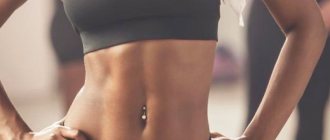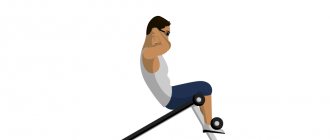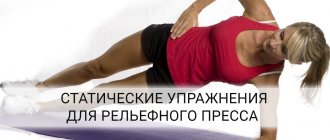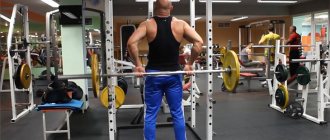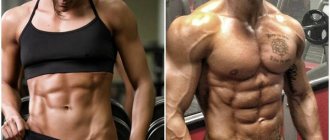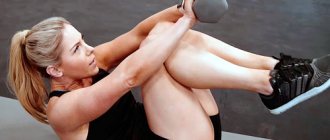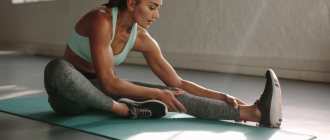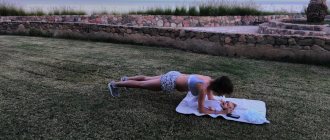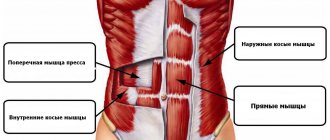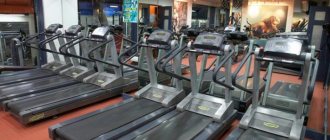How to draw cubes on the stomach
Contrary to popular belief, in order to see powerful abs on your stomach, it is not enough to simply pump up your abs.
The above exercises will work the rectus abdominis muscle. But it will still be hidden under a layer of fat, which is deposited primarily in the abdominal area.
Removing these fat deposits is a difficult task. In order to achieve success, you need to normalize your diet and regularly conduct fat burning workouts.
Nutrition for weight loss
The ideal basis of the diet for those who want to “get dry” while removing belly fat is protein foods (meat and fish), as well as vegetables and cereals. You should exclude fast carbohydrates, foods with a high glycemic index and fatty foods - flour, sweets, sausages and the like.
In this case, it is necessary to ensure that the number of calories consumed during the day exceeds the number of calories consumed with food.
Transitioning to an active lifestyle will help increase energy expenditure. In addition, to achieve results faster, you should include fat burning training in your program.
Exercises for weight loss
Traditionally, cardio training is recommended as the main way to burn excess fat. In the gym, you can exercise on any of the cardio machines - an exercise bike, treadmill, elliptical or any other.
There are also exercises for home cardio training, which do not require special exercise equipment or sports equipment.
Regularly performing abdominal exercises, normalizing your diet and training aimed at burning fat will definitely bear fruit - your stomach will become toned, and powerful rectus abdominis muscles will appear on it.
The main thing is perseverance, which will help you adhere to all the recommendations given month after month for many years.
Ab exercises with dumbbells
These workouts for the abdominal muscles are based on classic exercises that are performed with weights. This will not make them strong. At first, for women, dumbbells weighing 1-2 kg will be sufficient weight. For men, 5 kg is enough. Gradually the weight can be increased if desired. A warm-up is done to warm up the abdominal muscles being worked. The entire set of abdominal exercises is designed in such a way as to evenly work each individual zone and all areas of the abdomen together. How to pump up your abs with dumbbells at home to create a beautiful sculpted silhouette?
Exercises for the upper abs
This complex is aimed at working out the muscles of the upper abs with weights. The exercises are done measuredly and without jerking.
- IP: lie on your back, take a dumbbell in each hand. Bend your legs at the knees. Cross your arms over your chest. Slowly lift your shoulders off the floor, raising your body above the floor. The lower back remains in a stationary position. Next, return to the IP and after a second repeat the movement again. The abdominal muscles should not relax when you lie on your back again. 15 repetitions in 3 sets.
- IP: identical to the first abdominal exercise with dumbbells. Just extend your arms parallel to the floor in front of you. Raise the upper part of the body and then smoothly lower it. 15 repetitions in 3 sets.
- IP: lie on your back. Hands with dumbbells along the body on the floor. Raise your legs at an angle of 90 degrees relative to the body. As we inhale, we raise our arms up and reach for them, lifting our shoulders off the floor. Exhale – we lower ourselves into IP.
The last exercise works not only the muscles of the upper abs, but also the lower ones. If you lower your legs a little down (straight), the load on your stomach will only increase. Make movements without jerking, so as not to injure your back.
Recommended video: Exercises for the abdominal muscles with dumbbells.
Exercises for the lateral and oblique abdominal muscles
This area can also be worked with classic exercises using dumbbells:
- IP: lie on your back, cross your left leg over your bent right leg. Fix your left hand perpendicular to the body, take a dumbbell in your right. With your right elbow, begin to reach towards your left thigh, lifting your body. 15 reps. Next, change position to the opposite side.
- IP: lie on your back, bend your legs, place your feet completely on the floor. Holding dumbbells in your hands, alternately stretch to the right and then to the left side of the thigh.
- Abdominal exercise "Mill" gives excellent results. IP: stand straight, feet shoulder-width apart. Spread your arms to the sides, lower your body parallel to the floor, but your back remains straight, without bending. While maintaining balance, we swing our arms like a mill: turning the body, we strive to reach the left foot with our right hand and vice versa.
- Side bends. IP as in the previous exercise. Take a dumbbell in one hand, the other on your belt. Bend your body, sliding your hand with a dumbbell along the side of your thigh. Make the tilt as much as possible. The back is straight, no deviations back or forward.
In the process of performing these abdominal exercises, other muscles are also involved, for example, the lumbar region. But you still need to make sure that when performing the movement, it is the abdominal muscles that are tensed.
Lower press
To pump up the muscles of the lower abs at home, a pair of dumbbells and some household attributes are enough.
- IP: sit on a chair so that your buttocks are at the very edge of the seat, your feet need to be fixed. The gap between the floor and the sofa is suitable for this. Cross your arms over your chest and lower your body parallel to the floor. The exercise is done without jerking. When the body hangs in the air at the indicated point, immediately begin lifting the body up to the IP. To complicate the movement, take dumbbells in your hands.
- IP: lie on your back, arms extended along your body. Bend your legs at the knees. Hold the dumbbell with your feet. While inhaling, do leg lifts with a dumbbell. As you exhale, lower them. The amplitude of movement is maximum.
- IP: as in the previous one, only the legs are straightened. A dumbbell is also clamped between the feet. As you inhale, lift your legs, and as you exhale, lower them. This is an advanced version of the exercise.
Please note that other muscle groups may also be involved in the process of performing exercises. But at the same time, it’s better to try to transfer the main load to the press.
So, a lot has been said about how to pump up your abs with dumbbells at home correctly. The main thing to remember is that you need to strive to maintain your balance without swaying while doing the exercises. Only in this case will all these workouts bring maximum effectiveness for both men and women.
Exercises for back muscles
Basic exercises with dumbbells for training your back muscles at home:
- Trapeze with dumbbells. The shoulder shrug is a simple exercise, but the most successful for developing the upper trapezius. Take the dumbbell in your hands. The legs are wide at shoulder level, the stomach is pulled in, the shoulders are straightened, the chin is pressed to the chest. Raise the dumbbells lightly, trying to (figuratively) connect your shoulders at the back of your head, with a slight pull back and up. Then slowly lower your arms to the starting position. It is recommended to perform the exercise in two or three sets of 15-20 repetitions, starting with heavy weight and ending with lighter weight.
- Incline dumbbell row. The exercise is aimed at developing the largest muscles of the back with the involvement of the biceps. Tilt your body. The back should be almost parallel to the floor. Look straight, keep your back straight. Legs slightly bent at the knees. Hands with dumbbells should not be pushed forward. Pull the dumbbells towards your mid-abdomen. Watch your elbows - they should point up, not to the sides. Return to the starting position and repeat again.
Anatomy of the abdominal muscles
Beautiful abs for men are associated with the formation of the famous, clearly visible, embossed 6-pack (6 stands out well, and 2 is blurred below the umbilical cord), which create an attractive figure along with the development of other muscle groups.
For girls, they are interesting if they engage in professional bodybuilding or fitness, but in most cases, a flat stomach is a female dream that excites their minds and gives them no rest. Well-built and developed abdominal muscles are not only beautiful for showing off on the beach and causing the envy of others, but also good for health.
The muscles of the lower back and abdominal muscles support the internal organs, protect them from blows, create
a dense base for supporting the intervertebral discs of the lower back, strengthening it, preventing the occurrence of pain and other discomfort when bending over or lifting moderate weights.
By the way, remember, unfortunately, it is not possible to change the anatomy of the muscles; you have probably often seen that the left and right parts of the abs do not form perfectly straight lines, the cubes of one side are slightly shifted in comparison with the other. Don’t despair, when you get well-defined abs, they will look very effective, regardless of your natural characteristics.
To build beautiful abdominal muscles, let's figure out what muscles it consists of:
The rectus abdominis muscle occupies a large mass and covers the entire outer anterior part of the abdominal cavity, beginning from the lower part of the chest to the pubic region. Tendons run across the muscle, which, interrupting it, turn the abs into the long-awaited cubes. The main task is to tilt the body forward and raise the hips while keeping the upper body motionless.
Transverse abdominis muscle - lies deeper than all the muscles of the abdominal region, envelops the waist horizontally from the side. Its purpose is to twist the waist and tilt it to the sides, pulling the stomach inward.
The external oblique muscle is a large lateral abdominal muscle that covers the entire plane diagonally from top to bottom. Participates in raising and lowering the ribs, tilts and rotates the torso, and raises the hips when the upper body is stationary.
The internal oblique muscle of the abdomen is located in the thickness of the abdominal muscles, covered with the external external oblique muscle and runs diagonally from bottom to top. Its task is similar to the functions of others - it tilts the body, rotates it and tightens the hips while the chest is motionless.
Abs secrets
Abdominal muscles are classified as endurance muscles, so they cannot be built by doing 8 repetitions like arms. chest or back. To tire them out, you need to perform a large number of repetitions. do at least 25-40 times, with a feeling of the muscle and strict adherence to technique.
If you want clearly defined muscles while maintaining a narrow waist, forget about the exercise with additional weights
(dumbbells in your hands, weights on your legs or a weight on your neck), this way, of course, you will build your abdominal muscles and have six-pack abs, but your waist will increase in volume. Do a lot of reps with your own weight, the building period may be longer, but the results will be worth it.
Follow your diet. otherwise, all the fruits of your labor will be hidden under fat deposits, consume more vitamins and minerals, plenty of proteins, moderate carbohydrates and minimize fat intake.
If at the end of the exercise you feel a burning sensation in your abs, as if something was squeezing your stomach, then everything was done correctly, your back hurts - replace the exercise, if you don’t feel the muscle - you are violating the technique or not finishing it to the end.
It’s better to do fewer repetitions and better quality than a lot, but whatever.
Beautiful abs are not a myth, but a reality, take care of yourself and you yourself will be surprised by the effect achieved.
- Lateral raises
- Incline crunches
- Twisting on the top block
- Twisting in a simulator: technique and video
- Leg raises while lying on an incline bench
- Crunches lying on the floor
Rules for performing exercises
Such exercises are analogues of exercises without dumbbells. The main difference between them is that dumbbells provide weight, and therefore the desired result is achieved much earlier. When choosing dumbbells for training, you need to remember that their weight for each woman is determined individually (on average from 2 to 5 kg). The optimal weight will be that which is easy to hold with outstretched arms for a few seconds. In addition, fitness trainers recommend increasing the load over time: this way, the improvement in body shape will be noticeable faster. Increasing the load can be achieved in two ways:
- increasing the number of approaches (at least two sets of 12 repetitions);
- weight gain (by 1-1.5 kg once every 2-3 months).
However, when adding sets or weight, you need to listen to how you feel. If everything goes quite easily, then the actions performed are correct.
If we talk about the location of dumbbells, then they can be held on the chest or behind the head.
Exercises with dumbbells for women are available not only in gyms, but also at home. But if in the gym there is a trainer who will tell you how and what to do correctly, then at home there is no such opportunity. Therefore, every woman performing exercises with dumbbells should follow these recommendations:
Before training, you should definitely do a warm-up: it prepares the body for the load, in addition, it reduces the likelihood of injury.- Warm-up is performed in a certain order: first the joints and spine are warmed up, then stretching is performed.
- Warm-up should not be long, since it also consumes enough energy, and there is less strength left for further loads.
- It is important to always remember correct breathing: muscle tension should occur as you exhale, and relaxation should occur as you inhale.
It is recommended to train with dumbbells for the abs 2-3 times a week, with a break of 1-2 days between them so that the muscles can calm down. For better fat burning, you can add several hours of aerobics to such activities.
Exercises with dumbbells for the press train various abdominal muscles: internal and external obliques, transverse muscles.
How to pump up muscles for a child
Agree that almost every caring parent dreams of his child growing up to be a healthy and physically strong person. That is why, starting from early childhood, most of us try to introduce children to sports.
A wall bar placed in a child's room, cycling in the yard or professional training in a sports section - all this has a great effect on a child's physical fitness.
However, some parents (particularly dads) are often interested in the question: is it possible for a child to build muscles? In other words, is there strength training for children? We decided to answer this question and share recommendations from experts in the field of children's sports in our publication today.
Helpful advice!
To begin with, this type of training not only develops endurance and agility in a child, but also improves bone mineral density, and also regulates blood cholesterol levels, helping to maintain a healthy body weight.
Moreover, even if your child is already involved in a sports section, additional strength exercises performed at home will increase his physical fitness and improve results. Moreover, your child will not have to carry heavy dumbbells or exercise on exercise machines.
Simple exercises that challenge your body will make your baby stronger, improve his metabolism, and build muscle.
Experts in the field of children's sports are confident that, subject to safety precautions and proper training, exercises that allow a child to build muscles can be performed between the ages of three and five years. At the same time, such activities do not cause any harm to the growing body.
Such exercises include push-ups, pull-ups, leg and body lifts.
https://www.youtube.com/watch?v=A0BmUPKDbZo
Between the ages of six and nine, children are allowed to use sports equipment to add a little extra challenge. These can be light dumbbells, expanders, various balls, gymnastic sticks and other lightweight items.
It is important to note that when doing strength training with your baby, make sure that all exercises are performed correctly and slowly. The fact is that such activities, if safety precautions are not followed, lead to injury to the child.
Therefore, the child is never left unattended during classes.
To build muscle, your baby needs two or three strength training sessions a week. At the same time, he must understand how important regular exercise is. You can give examples of heroes from movies and cartoons who are distinguished by their strength.
Pay attention!
If your child is involved in a sports section, then you need to agree with the coach on the introduction of strength loads and take into account his recommendations on the selection of exercises. Well, to avoid injuries during training, consider the approximate lesson plan for your child:
- Within ten minutes, the baby should warm up thoroughly: brisk walking, jogging or jumping rope are ideal for warming up.
- Exercises with a gymnastic stick or ball will help pump up the muscles of your arms, as well as your shoulders, legs, stomach, upper and lower back.
- To develop balance and improve range of motion, you need to perform one exercise each for the joints of the arms, legs and spine.
- Exercises with resistance and using your own weight are performed with 10 repetitions: push-ups, squats, pull-ups on the horizontal bar, lifting the legs and torso from a lying position.
- As a cool down, you need to do a few simple stretching exercises.
Such a well-constructed strength training plan will allow your baby to pump up muscles, become stronger and more resilient.
Good luck and great results!
How to pump up your abs on the horizontal bar
Exercises on the horizontal bar are the best way to pump up your abs. This is due to the fact that the horizontal bar allows you to stretch the rectus abdominis and oblique muscles to the greatest extent at the same time. And the more a muscle is stretched, the more force it needs to contract. And the greater the effort, the stronger the muscle becomes.
A classic abdominal exercise on the horizontal bar is hanging leg raises.
You need to hang on the bar and raise your legs until your legs are parallel to the floor.
In fact, there are many modifications and it all depends on your training. If at the beginning of your training you find it difficult to lift your legs straight, then start by lifting your legs with your knees bent. If straight legs are not a problem, then you can raise them not to the waist, but immediately to the crossbar.
If this is easy for you, then raise your legs to the crossbar and begin to lower them alternately in one direction or the other.
In fact, the main limitation for long-term abdominal work on the horizontal bar is not the abdominal muscles, but the arm muscles. They get tired much faster and you may not have time to work on your abs enough, and your arms will already be so weak that you won’t be able to hang on them.
But in this case, I have advice - use Beresha loops. These are special straps that are attached to the horizontal bar and your hands are put into them. With such loops, your arms will not get tired at all and you will be able to effectively work out your abs without wasting strength on your arms.
You can buy them at any sports store and it’s not difficult to make yourself.
The beginning of time
Before choosing a suitable training complex for the press, you should critically evaluate yourself and your capabilities. Excess weight and excess subcutaneous fat cannot be removed by any lifting of the torso, because abdominal exercises are strength loads (aimed at working the target muscle group) and their task is not to consume kilocalories, but to add strength and endurance to the muscles. Correction of nutrition and cardio exercise, for example, running or jumping rope, will cope with fat accumulation in men much faster and better. Fitness trainer Denis Gusev recommends that men first of all “get dry” (get rid of excess weight), and only then start strength training.
Ab exercises with dumbbells
It is a known fact that the key to a beautiful and slender figure is toned abs. That is why we are trying to find good, effective exercises that will provide us with sculpted “cubes” on our stomach in a short time.
Nowadays there are many effective exercises and techniques, which, if performed correctly, results will come very soon.
Attention!
But, if you think that this is not enough for you, we bring to your attention exercises for abdominal “cubes” with dumbbells.
To quickly achieve the desired results, additional stress on the muscles will come in handy. It should be noted that the main thing is not the number of repetitions performed, but the number of approaches and the difference in exercises. We’ll look at how to build a six-pack with dumbbells below.
Six pack training with dumbbells
Ab workouts with dumbbells are based on basic abdominal exercises using weights. Dumbbells can be placed either in front of you or behind your head.
At the beginning of training, it is better to use a small weight (up to 3 kg) and then, training after training, increase it. Before starting strength training, you need to do a warm-up to warm up your muscles.
In order to create a slender and sculpted silhouette, you should practice alternating loads on different muscle groups in combination with abdominal training with dumbbells.
- Exercises to train the upper abdominal muscles.
In order to perform the first exercise, you need to lie on your back and take a dumbbell in each hand. We bend our knees and, placing our hands on our chests in a cross, begin to quietly lift our shoulders off the floor, keeping our lower back motionless.
There is another highly effective option. The starting position is the same as in the first option, but the arms are extended parallel to the floor. Raise the upper part of the body 15 times. Exercises are done in several approaches.
In order to try to perform exercises for the upper and lower abs, using a load in the form of dumbbells, you need to lie on your back, place your arms along your body, and create a right angle between your legs and the floor.
- Exercises to train the oblique and lateral abdominal muscles.
To train these muscles, we take the following position - having bent the right leg in advance, we throw the left one over it. We extend our left arm and firmly fix it perpendicular to the body, while bending our right arm together with the dumbbells. Next, we begin to stretch our right elbow to our left thigh. After 15 repetitions, change the arm and leg.
The effectiveness of this exercise lies in the fact that it loads not only the oblique muscles, but also the lumbar muscles. There is another useful exercise. In the starting position, you need to lie on your back, bend your legs, and place your feet firmly on the floor. Taking dumbbells in our hands, we begin to stretch first to the right leg, then to the left.
The point of the exercise is that the abdominal muscles receive the load, and not the legs and back.
Let's move on to the next well-known exercise, “The Mill,” which also gives good results. Starting position: standing, feet shoulder-width apart. We direct our arms in different directions and, without bending, tilt the body forward. Having secured yourself in this position, we begin to swing our arms, while trying to touch the fingers of our hand to the opposite toe of the foot.
Since childhood, in physical education lessons, we were taught to bend the body to the sides. To perform this exercise, we will need a medium weight dumbbell. We have a dumbbell in one hand, and the other hand rests on the waist. And now we carefully begin to lower the hand with the dumbbell parallel to the leg, while trying to get as low as possible. You should not lean forward in this exercise.
- Lower abdominal muscle training.
If you want to tone your lower abdominal muscles, you need to do “chair sit-ups.” Starting position - sit on a chair, fixing your feet (the distance between the floor and the sofa will help you do this).
Next, we begin to tilt the body parallel to the floor, first placing our hands on our chest. The main thing is to make sure that your buttocks are on the edge of the chair. Now we carefully rise to the starting position.
To increase the effectiveness of the exercise, you can hold a dumbbell in each hand.
Here is another equally effective exercise for the lower abs. In the starting position, lie on your back and stretch your arms along your body. As we inhale, we raise our legs, as we exhale, we lower them, but at the same time we try to perform the exercise with maximum amplitude.
Important!
Now, after reading this article, you understand how to make your abs even more attractive and sculpted.
Full body muscle exercise program with dumbbells at home and in the gym
- Shrug. 4 sets of 15-20 reps (first 10 reps should be slow, control 2 negative seconds and stop. Then finish with fast reps).
- Technique for performing bent-over dumbbell pull-ups. 4 sets of 8-12 reps (2-4 negative seconds, 1-2 positive seconds).
- Single leg deadlift. 4 sets of 20 reps (2-4 negative and positive seconds).
- Push ups. 4 sets of 15-20 reps (squeeze the dumbbells instead of placing your hands on the floor, doing 4 negative and positive seconds each).
- Jump from a squat. 4 sets 30 seconds (goblet grip dumbbells)
- Lunges with steps. 4 sets of 10-15 repetitions.
Lesson outlines
You can choose one of the options described below. For constant progress, after 2-3 months, change the selected training regimen to another.
For men
| Option 1 | Option 2 | Option 3 |
Monday. Back and shoulders:
| Tuesday. Chest and triceps:
| Monday. Back and shoulders:
|
Wednesday. Chest and triceps:
| Thursday. Back and biceps:
| Wednesday. Chest and triceps:
|
Friday. Legs and biceps:
| Saturday. Legs and shoulders:
| Friday. Legs and biceps:
|
For ladies
| Option 1 | Option 2 | Option 3 |
Monday. Back and shoulders:
| Tuesday. Chest and triceps:
| Monday. Back and shoulders:
|
Wednesday. Chest and triceps:
| Thursday. Back and biceps:
| Wednesday. Chest and triceps:
|
Friday. Legs and biceps:
| Saturday. Legs and shoulders:
| Friday. Legs and biceps:
|
Workout 1 Chest and back week 1
1A Bench press on the floor
Sets: 4, reps: 10, rest: 0 sec, tempo: 2010
Technique: Lie on the floor, holding dumbbells with straight arms above your chest. Lower the weight to your chest, then lift it up to the starting position.
Note: Lying on the floor provides you with a stable position that allows you to handle heavier weights. The range of motion here is shorter than the classic bench press, so focus on properly contracting your chest muscles.
1B Bent-over row with hammer grip
Sets: 4, reps: 10, rest: 0 sec, tempo: 2010
Technique: Hold a dumbbell in each hand with your palms facing each other. Bend forward and then pull the dumbbells toward your chest. Using a controlled movement, lower the weight back to the starting position.
Note: This exercise targets the large muscles of the upper back. Its lower part is under tension to support the torso in an inclined position. The hammer grip allows you to work your forearms.
2A Push-ups with dumbbells
Sets: 4, reps: 10, rest: 0 sec, tempo: 2010
Technique: take dumbbells, take a lying position with your hands shoulder-width apart. Brace your core and straighten your body into a straight line from head to toes. Bend your elbows, lower your body, and then with an energetic movement, straighten your arms and return to the starting position.
Note: Push-ups are effective for building chest muscles, especially when you use dumbbells to add instability to the movement, which forces your core muscles to engage.
2B Bent-over dumbbell raises
Sets: 4, reps: 10, rest: 60 sec, tempo: 2010
Technique: Hold a light dumbbell in each hand and lean forward without rounding your back. Maintaining a slight bend in your elbows, lift the dumbbells to shoulder height, then lower them back to the starting position.
Note: This exercise literally works wonders for your upper back and rear deltoids. Start with light weights and master the technique thoroughly to maximize muscle strength and reduce the risk of injury.
3A Wide Hand Push-Ups
Sets: 4, reps: 10, rest: 0 sec, tempo: 2010
Technique: Take dumbbells, lie down, spread your arms wide and bring your legs together. Brace your core and straighten your body into a straight line from head to toes. Bend your elbows to lower your body, and then vigorously straighten your arms and return to the starting position.
Note: Wide stance reduces the involvement of the triceps and shoulders, so that the main load falls on the chest muscles.
3B Lying dumbbell row
Sets: 4, reps: 10, rest: 60 sec, tempo: 2010
Technique: take dumbbells, lie down with your hands shoulder-width apart. Brace your core and straighten your body into a straight line from head to toes. Pull one dumbbell toward your chest, lower it back down, and then repeat with the other arm.
Note: One movement of this exercise works one side of your upper back (so you can fully target every muscle) and also forces you to engage your core and shoulder joints to keep your body in a stable position.
Week 2
| Exercise | Approaches | Repetitions | Rest, sec | Pace |
| 1A Bench press on the floor | 4 | 12 | 2010 | |
| 1B Bent-over row with hammer grip | 4 | 12 | 60 | 2010 |
| 2A Push-ups with dumbbells | 4 | 12 | 2010 | |
| 2B Bent-over dumbbell raises | 4 | 12 | 60 | 2010 |
| 3A Push-ups with wide arms | 4 | 12 | 2010 | |
| 3B Lying dumbbell row | 4 | 12 per side | 60 | 2010 |
Week 3
| Exercise | Approaches | Repetitions | Rest, sec | Pace |
| 1A Bench press on the floor | 4 | 10 | 2010 | |
| 1B Bent-over row with hammer grip | 4 | 10 | 60 | 2011 |
| 2A Push-ups with dumbbells | 4 | 10 | 2010 | |
| 2B Bent-over dumbbell raises | 4 | 10 | 60 | 2011 |
| 3A Push-ups with wide arms | 4 | 10 | 2011 | |
| 3B Lying dumbbell row | 4 | 10 per side | 60 | 2010 |
Week 4
| Exercise | Approaches | Repetitions | Rest, sec | Pace |
| 1A Bench press on the floor | 5 | 12 | 2010 | |
| 1B Bent-over row with hammer grip | 5 | 12 | 60 | 2011 |
| 2A Push-ups with dumbbells | 5 | 12 | 3010 | |
| 2B Bent-over dumbbell raises | 5 | 12 | 60 | 2011 |
| 3A Push-ups with wide arms | 5 | 12 | 3010 | |
| 3B Lying dumbbell row | 5 | 12 per side | 60 | 2011 |
Shoulder exercises
An attractive, athletic body also includes developed shoulders. So warm up and start doing the most effective exercises for strong and expressive shoulders.
- Seat press. We train the sides of the deltoid muscle. Performing this exercise systematically will give you wider shoulders. Sit on a bench/chair/stool and lean back against the back/wall. Keep your body upright throughout the exercise. Hold the dumbbells in your hands with your forearms pointing straight up. Not sharply, but with an intense movement, squeeze the dumbbells. Try not to straighten your elbows forward. Pause at the top and smoothly return to the starting position. There's no point in stopping here, so start pressing again.
- Arnold press. The Arnold Press exercise uses the deltoid muscle, as well as the trapezius muscle and triceps minor. Sit down. Keep your spine straight and your back should be straight. Hold the dumbbells in front of you with your palms facing you. Elbows pressed to the body.
- Start lifting the dumbbells up while turning your palms forward. Raise the dumbbells and extend your arms almost all the way (but not completely), making a movement in the opposite direction with your palms returning to their original position. This wrist movement and altered line help increase the load on the anterior deltoid muscles. The Arnold Press involves muscle fibers that are not used in a traditional dumbbell press.
- Rocker. Swings with dumbbells in your hands load the lateral (middle) muscles and work the delta deeper. For this exercise, choose a light weight. Take dumbbells, stand straight and slightly bend your elbows (this position should be maintained throughout the entire approach). Pull the dumbbells vigorously to the side until you reach head level. Wait. Now slowly lower your arms and rise again. Repeat as many times as necessary. Exercises are allowed in a sitting position.
